21 Types of Salami for Endless Delicious Flavor
Author: Anne Cowart | Editor: Omar Alonso
Review & Research: Jen Worst & Chris Miller

Whether you put them on pizza, in a sandwich, in a salad, pair it with wine and cheese, or eat it as is, there’s no denying that all the different types of salami are mouth-wateringly delicious deli meat.
If you thought that there was only one type of salami, though, you’re highly mistaken. Salami-lovers, rejoice — there are as many as 20-plus varieties of this yummy cold cut.
21 Types of Salami
Read on for some salami-enlightenment. Though salami hails from Italy, the people of other nations picked up the concept and developed their own styles as well. There are many tastes, ingredients, and methods of making these types of sausage for you to explore.
Genoa Salami
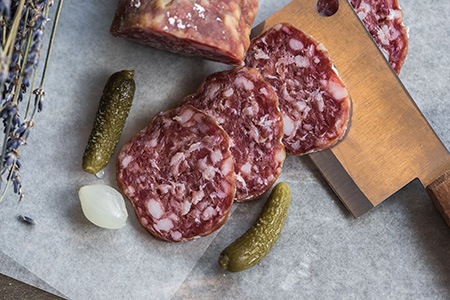
We start with the most common type—the humble-but-lip-smackingly delicious Genoa salami. Originally hailing from Italy’s Genoa region (hence, the name), this kind of salami is now produced around the world.
Pork is ground to a medium consistency, after which it is flavored with a range of ingredients—the primary two being garlic and red wine — which lend it its distinctive flavor. The mixture is then dry-cured, after which these salami varieties are usually sliced and served.
Soppressata
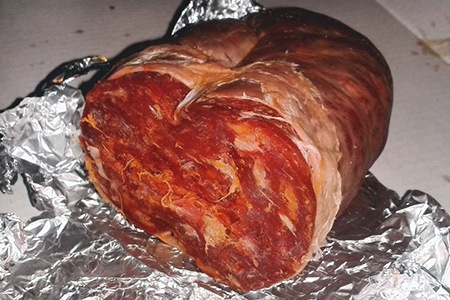
Another Italian staple, soppressata is a traditional pork-only salami made using meat that’s ground or minced, with a lining of pork fat. This kind of salami, if made with cracked black pepper, is only mildly spicy, and if made with crushed Calabrian peppers, can set your tongue on fire.
There are many versions of Soppressata in Italy, but the two main and easily distinguishable variants are the cured and uncured variety, though some break it up as white, sweet, and spicy sopressata.
Soppressata is quite firm to the touch and some folks may find it a little chewy. It also has higher fat levels than most other different types of salami.
Wine Salami

If you guessed that this is salami cured using wine, you’re spot on. Instead of the traditional method of salting to dry the meat, wine salami uses alcohol, primarily wine, for drying — perfectly logical, considering that wine and salami are a match made in heaven when eaten together.
Also called as wine-soaked salami, wine salami is dried in fine white or red wines—typically sweet, fruity wines that give wine salami its primary flavor.
Finocchiona Salami
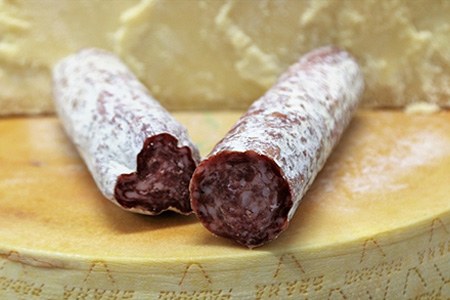
As if Italy’s gorgeous Tuscan lands didn’t have enough treasures, here’s another addition to the list — finocchiona salami, the perfect mix of toasted fennel, seasonings, and ground pork.
Though the other spices, condiments, and seasonings used may differ from region to region, the signature ingredient in these kinds of salami is the fennel; in fact, it gets its name from the Italian term for the spice.
This classic Tuscan salami has quite a few fun origin stories, from fennel being a cheaper substitute for pepper to a happy accident when salami stashed in a field of growing fennel soaked up all the flavors and smell of fennel by the time it was retrieved.
Hard Salami
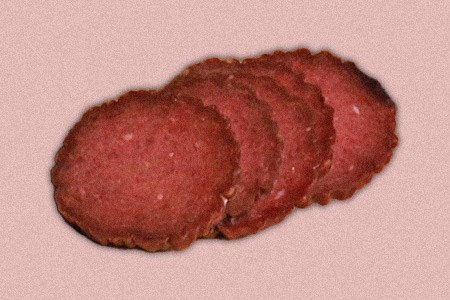
One of the few salami types that can’t be attributed to Italy! Meet hard salami, originating from Germany and commonly found in central and eastern Europe.
Hard salami is recognizable by its distinct marbled look, a feature that it shares with Genoa salami and the cause of confusion between buyers. However, hard salami is much firmer, with a stringy texture and very little moisture, making it hard to chew.
You can make hard salami by mixing beef and pork, or just with pork alone. The meat, mildly flavored with spices and salt (no wine), is cured, smoked, and immediately consumed, without allowing fermentation. Time only reduces the taste and flavor.
Chorizo
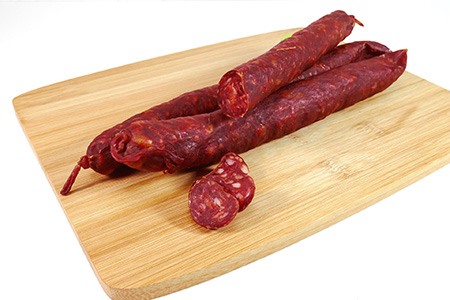
This dried, piquant salami is a staple in Spanish cuisine, with rich notes of garlic, spices, smoked paprika, and herbs. You’ll find both Spanish and Mexican versions of this ground-pork salami, but whichever one you try, you’re assured of deliciousness.
The primary difference between the Spanish and Mexican types of salami is that the former uses a mix of spices and ground pork which is then cured and sold (which is why it’s drier and harder), whereas the latter is sold uncooked (and is moister).
It’s important to note that only chorizo that’s been cured is considered salami (curing is an integral part of the salami-making process), which is why Mexican chorizo is often not considered to be in the same class as salami.
Pepperoni
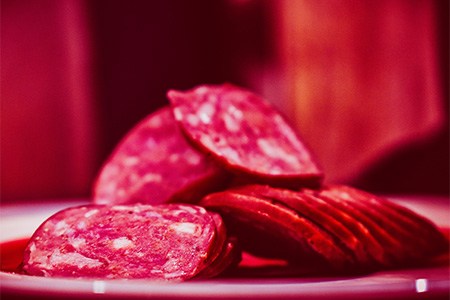
Proudly American, pepperoni is an Italian-style cured salami that gained popularity through America’s many Italian-run butcheries of the early 20th century. A popular pizza topping in the country, pepperoni is beloved for its sweet and smoky flavor.
Pepperoni salami varieties can be made with either seasoned beef or pork, usually flavored with paprika and smoked to produce its signature flavor. The salami is quite soft to the touch and has gorgeous red coloring.
Guanciale
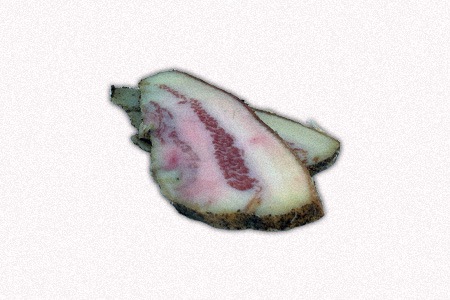
Made of salt-cured pig jowls, guanciale is commonly used in adding flavor to the amatriciana and carbonara sauces due to its extremely high-fat content; otherwise, it’s best eaten cooked.
To amp up the flavor, spices such as pepper, juniper, and bay leaves are also used to cure the cheek meat. You can enjoy guanciale much like you would any types of pâté.
Capocollo
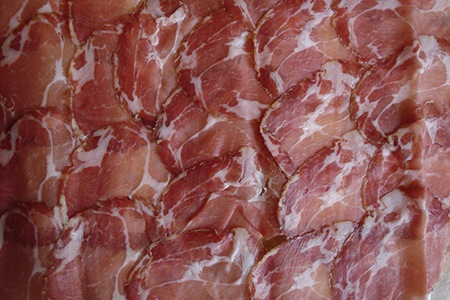
Bright red color and marbling from the fat content characterize capocollo, also referred to as capicola and coppa. This salami is made from the back part of a pig’s neck as well as from the top shoulder portion. The entire muscle is then dry-aged/cured for around 30 days.
Different regions use different seasonings, including wine, cinnamon, cloves, chili, nutmeg, or only salt. The high-fat content in the meat used gives this salami a naturally sweet flavor and soft texture unless a lean cut is used.
Peppered Salami
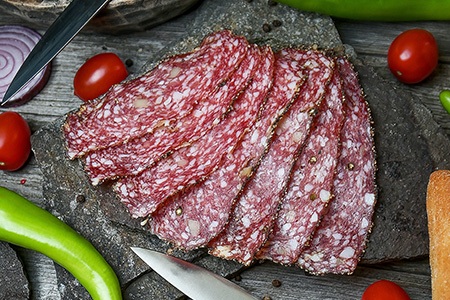
Peppered salami, as the name suggests, features pepper—and quite a lot of it! Finely ground meat is covered with a coat of black pepper, resulting in a spicy salami that’s best eaten in a sandwich or with a nice Chianti and some cheese on a charcuterie board.
Bresaola
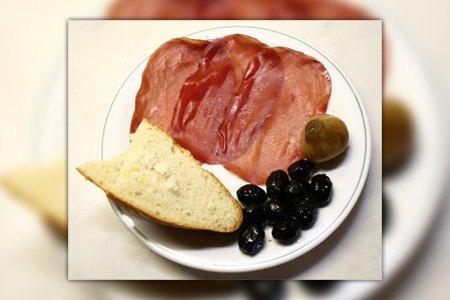
Unlike traditional types of salami, bresaola is entirely red, lean beef, cured using pepper and salt. The salami is a result of several months of drying (at least six), and sometimes, subtle smoking to elevate its naturally earthy flavor.
Veal can also be used to make bresaola, with the same curing and drying process.
Cacciatore Salami
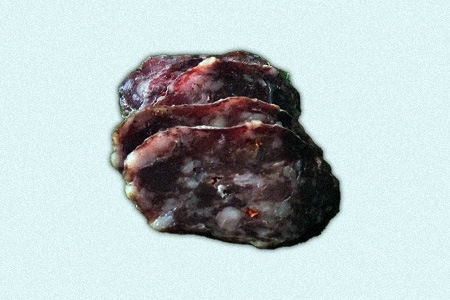
This minimally spiced, semi-dry salami was named by Italy’s hunters, due to which it’s also referred to sometimes as the “hunter’s style salami”.
Despite a simple cooking process, the salami packs a ton of nutrients and a naturally meaty and smoky flavor, making it a quick and convenient meal option and leading to it becoming a favorite of the hunting community.
Cacciatore salami types are made from pork shoulder that undergoes curing for a year and a half, with basic spices such as garlic, black pepper, and salt incorporated minimally. After the curing, the salami is further left to dry out for a couple of months before it can be savored.
Felino Salami
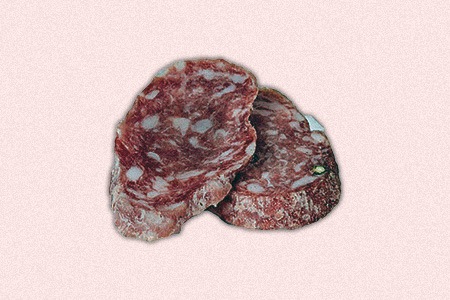
The namesake of Italy’s town of Felino, the “king of salami” is rich in flavor, smooth in texture, and excellent in taste, made with peppercorns, garlic, types of spices, salt, cane sugar, pork, and a fine red Chianti. The peppercorns and wine give this salami a delicate flavor, with slow aging intensifying it.
Cotto Salami
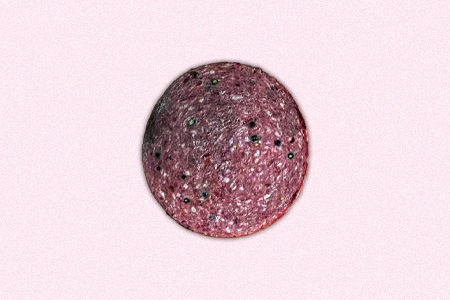
Another Italian gemstone, the secret to cotto’s deliciousness is the mixture of finely ground beef and pork, with sugar, peppercorns, cinnamon, mace, nutmeg, milk, and salt incorporated into the mix.
The entire thing is air-dried, as opposed to smoking or cooking. Due to this, cotto is quite a soft salami with quite a limited shelf life.
Mortadella
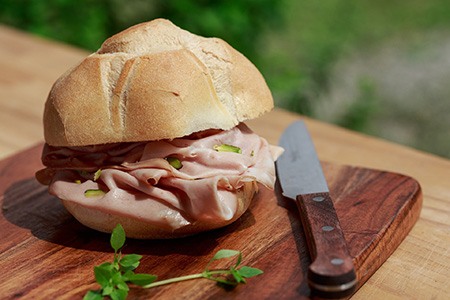
A beautiful blushing punk, mortadella is made with finely ground and cured pork that’s air-dried, with a range of ingredients added in, such as myrtle berries, salt, spices, and even pistachios.
The signature feature of this salami is the 15% pork fat that’s infused into it before curing. It can be eaten right away after slicing.
Salsiccia
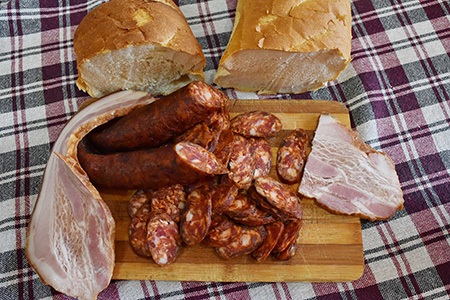
One of the oldest types of sausages in the world, salsiccia is also considered one of the types of salami. Bits of pork neck and scraps of pancetta are coarsely chopped and flavored with cinnamon, white wine, pepper, thyme, and garlic, and this may or may not be dry-cured.
There are versions of these salami kinds that also incorporate caciocavallo cheese, fennel, sun-dried tomatoes, and chili.
‘Nduja
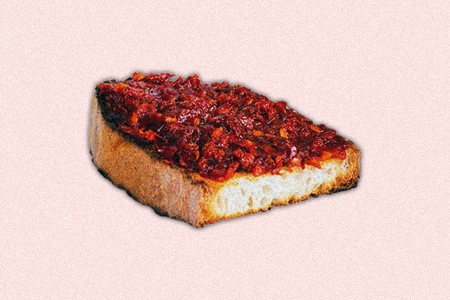
Hailing from the south of Italy, this quirkily named salami is packed with bold flavors that explode in the mouth when you eat it! Pepper, lemon, salt, and garlic come together to make offal, shoulder meat, cheek meat, and belly meat spicy and flavorsome.
Pancetta

Italy’s version of bacon, pancetta, is made by tying rolled-up cured pork belly, with equal proportions of fatty and lean meat. For seasoning, spices, pepper, and salt are used in these different kinds of salami.
Lardo
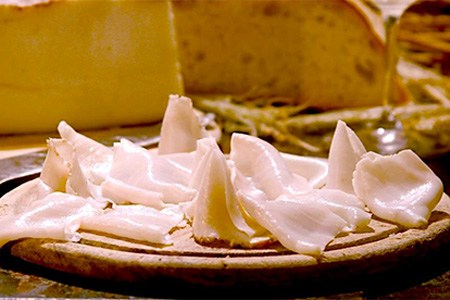
The king of cholesterol content, lardo (which is just Italian for “lard”) salami varieties are made from cured fat from the pig’s back region, and is great for eating as is or for cooking; in the latter case, it lends a nice tangy, buttery flavor to the food.
Speck
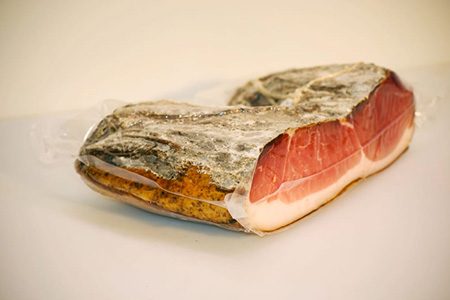
Made from pork loin, speck is a different salami, which is a salt-cured, smoked salami, flavored with rosemary, pepper, juniper berries, and salt, all of which lend it a distinct salty, smoky flavor.
Prosciutto
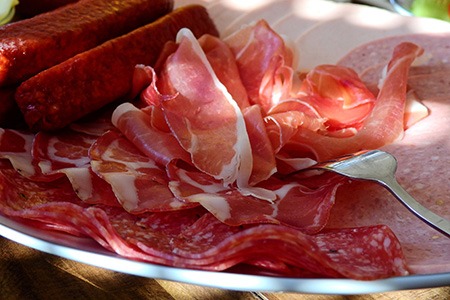
Rounding off the list is the prosciutto salami types, typically made from the shoulder or leg regions of the animal, though other variants exist. The meat is smoked, boiled, or roasted, and enjoyed for the rich taste and tender texture.
Types of Salami to Explore With Your Taste Buds
It’s amazing how many delicious yet different types of salami exist in the world and this is by no means an exhaustive list. Each part of the world has its own version of salami, today, but for starters, try eating your way through this list.




